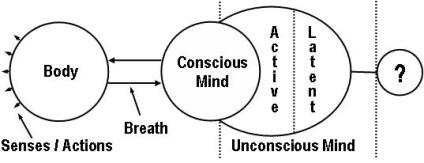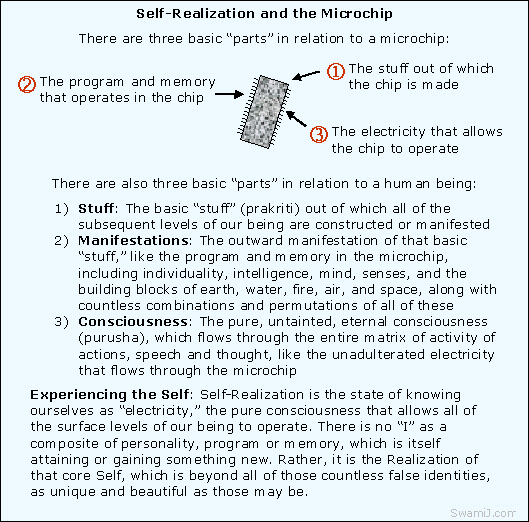|
|
Yoga
Sutras 3.53-3.56:
Higher
Discrimination
Through Samyama
(Previous
Next Main)
 The subtlest discrimination: Knowledge
of the distinction between the purest aspect of mind (sattvic buddhi) and
consciousness itself (purusha) brings supremacy over all forms or states
of existence, as well as over all forms of knowing, as was previously
described (3.50). The subtlest discrimination: Knowledge
of the distinction between the purest aspect of mind (sattvic buddhi) and
consciousness itself (purusha) brings supremacy over all forms or states
of existence, as well as over all forms of knowing, as was previously
described (3.50).
It also brings absolute liberation:
However, that discrimination between that purest
aspect of mind (sattvic buddhi) and consciousness itself (purusha) will
bring them to a point of equality. This brings absolute liberation,
independence, or freedom (kaivalya) (3.56).
Samyama on moments and succession:
Experience comes like a movie, with individual frames coming in a
succession, which creates the appearance of reality. By samyama on that
inner process of mental construction, there comes higher knowledge (3.53).
This applies to all types of objects:
This process of moments and succession occurs with all types of mental
objects, regardless of how gross or subtle. Samyama is practiced with all
of these types or levels, bringing discrimination between objects only
appearing to be similar (3.54).
Transcendent knowledge and liberation:
This process of subtle discrimination brings the higher, intuitive,
transcendent knowledge (3.55) and leads to final
liberation or kaivalya (3.56).
top
3.53
By samyama over the moments and their succession, there comes the higher
knowledge that is born from discrimination.
(ksana tat kramayoh samyamat viveka-jam jnanam)
[Note: In some renditions this is
sutra 3.51 or 3.52]
- ksana = moment, instant,
infinitesimal time (3.9)
- tat = its
- krama = sequence,
succession
- samyama = dharana
(concentration), dhyana (meditation), and samadhi taken together (3.4)
- viveka = discrimination,
discernment
- ja = born of
- jnana = knowledge,
gnosis
Moments and succession: Experience
usually comes like a movie. It only appears to be an unfolding
process, whereas it is actually independent events. It is like the movie
film being many independent frames, all of which coexist on the same reel.
However, when you look at those frames sequentially, there is the
appearance of a uniform and unfolding event or process.
Beyond moments and succession:
When samyama (3.4-3.6) is done on the
moments and the process of succession, the higher knowledge of what is really
going on is revealed. One comes to see the nature of movie production of
the mind and virtually the whole of the creation process. This opens the
door to the realization of the Truth (1.3).
This applies to all types of objects:
Throughout the Yoga Sutras, particularly Chapter 3, there are many
different objects mentioned for exploration and setting aside so as to go
past ignorance (2.5) and false
identities (1.4) to the true Self (1.3).
However, every one of those objects, regardless of its type or subtlety is
constructed in the same way, being moments of experience coming together
in succession. Thus, this process of applying samyama (3.4-3.6)
to moments and succession is an extremely subtle and far reaching
practice, effecting all possible sequences of experience or thought.
top
3.54
From that discriminative knowledge (3.53) comes awareness of the
difference or distinction between two similar objects, which are not
normally distinguishable by category, characteristics, or position in
space.
(jati laksana desha anyata anavachchhedat tulyayoh tatah pratipattih)
[Note: In some renditions this is
sutra 3.52 or 3.53]
- jati = genus, species,
category, type
- laksana = time
characteristics, appearance, distinctive mark
- desha = place, position
in space
- anyata = distinction,
separateness, difference
- anavachchhedat =
undefined, not separated, indistinguishable
- tulyayoh = of two
similar objects, the same category or class, equal
- tatah = thereby, from
that
- pratipattih = knowledge
distinction, distinguishable knowledge
Discrimination between similar objects:
Coming with the ability to discriminate between moments and succession (3.53)
is an increasing ability to discriminate between similar objects, which
might usually be perceived as one and the same. Gradually, this subtler
discrimination leads one to see past the mere appearances, and go to the
subtler, underlying reality. Recall that this process was described
earlier in relation to separating a word or name going with the object,
the meaning or identity of that object, and the knowledge associated with
that object (1.42).
Seeing past appearances: Through
this process of seeing past appearances of the nature of objects, all
objects are gradually and systematically seen to be mere constructs, and
are set aside. Eventually the eternal consciousness is revealed (1.3).
top
3.55
That higher knowledge is intuitive and transcendent, and is born of
discrimination; it includes all objects within its field, all conditions
related to those objects, and is beyond any succession.
(tarakam sarva visayam sarvatha visayam akramam cha iti viveka jam jnanam)
[Note: In some renditions this is
sutra 3.53 or 3.54]
- tarakam = transcendent,
intuitional,
- sarva = all
- visayam = objects,
conditions, pursuits
- sarvatha = in all ways,
by all means
- visayam = objects,
conditions, pursuits
- akramam = beyond
succession, non-sequential
- cha = and
- iti = this
- viveka = discrimination,
discernment
- ja = born
- jnana = knowledge,
gnosis
Higher knowledge comes from within:
The higher knowledge is intuitive, transcendent, or coming from within. It
is revealed by discrimination between objects (3.54),
which rests on the ability to discriminate between moments and succession
(3.53). Saying that the higher knowledge is intuitive
means that it is self-existent rather than being constructed knowledge.
Much of our worldly sense of knowledge comes from combining different
pieces of information, much like we might combine different cooking skills
and ingredients in a kitchen to construct a meal. However, the
higher knowledge is not constructed, but revealed by stepping beyond the
mere appearance of the moments and succession.
It is born of discrimination:
Through the repeated process of discrimination, the higher truth is born
or revealed. Here again, birth is beyond used as a means of expressing the
coming out or coming forth process, rather than the process of
construction of parts.
Higher knowledge includes all the
objects: As the meditator experiences this truth beyond the objects,
moments, and sequences, it becomes clear in direct experience that the
higher knowledge contains, or oversees all of the many objects, their
conditions, and sequences. It is seen that it is not a case where
consciousness not only permeates the objects, conditions, and sequences,
but actually is the supporting reality of their existence.
top
3.56
With the attainment of equality between the purest aspect of sattvic
buddhi and the pure consciousness of purusha, there comes absolute
liberation, and that is the end.
(sattva purusayoh suddhi samye kaivalyam iti)
[Note: In some renditions this is
sutra 3.54 or 3.55]
- sattva = purity aspect
of mind field or chitta, subtlest individuation, purest aspect of buddhi
- purusayoh = pure
consciousness
- suddhi = purity
- samye = equality
- kaivalyam = absolute
liberation, independence, freedom
- iti = this, end, finish
Levels of discrimination:
Discrimination is the finer tool for attaining enlightenment (2.26-2.29),
and is applied to the ever subtler levels of experience (3.4-3.6).
The subtlest discrimination: Knowledge
of the distinction between the purest aspect of mind (sattvic buddhi) and
consciousness itself (purusha) brings supremacy over all forms or states
of existence, as well as over all forms of knowing, as was previously
described (3.50).

It also brings absolute liberation:
However, that discrimination between that purest
aspect of mind (sattvic buddhi) and consciousness itself (purusha) will
bring them to a point of equality. This brings absolute liberation,
independence, or freedom (kaivalya).

This is the end: This absolute
liberation or kaivalya is the end, the final state of the Self in itself.
Thus, the word iti is the last word of the sutra and of this
chapter.

The
next sutra is 4.1
Home
Top
-------
This site is devoted to
presenting the ancient Self-Realization path of
the Tradition of the Himalayan masters in simple, understandable and
beneficial ways, while not compromising quality or depth. The goal of
our sadhana or practices is the highest
Joy that comes from the Realization in direct experience of the
center of consciousness, the Self, the Atman or Purusha, which is
one and the same with the Absolute Reality.
This Self-Realization comes through Yoga meditation of the Yoga
Sutras, the contemplative insight of Advaita Vedanta, and the
intense devotion of Samaya Sri Vidya Tantra, the three of which
complement one another like fingers on a hand.
We employ the classical approaches of Raja, Jnana, Karma, and Bhakti
Yoga, as well as Hatha, Kriya, Kundalini, Laya, Mantra, Nada, Siddha,
and Tantra Yoga. Meditation, contemplation, mantra and prayer
finally converge into a unified force directed towards the final
stage, piercing the pearl of wisdom called bindu, leading to the
Absolute.
|
|



